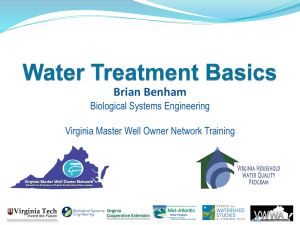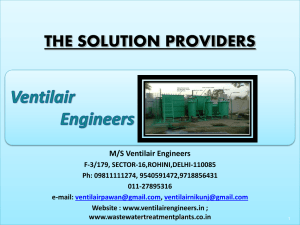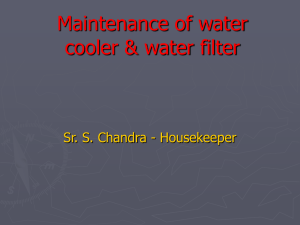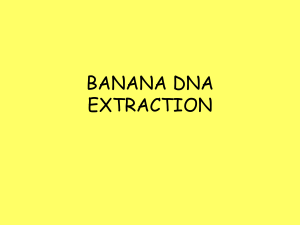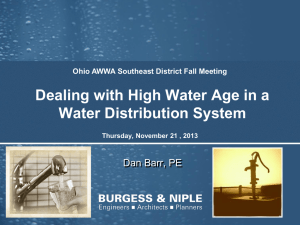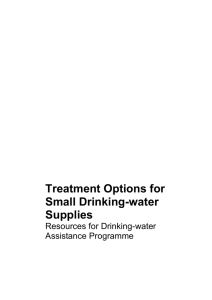Water Treatment - Virginia Household Water Quality Program
advertisement
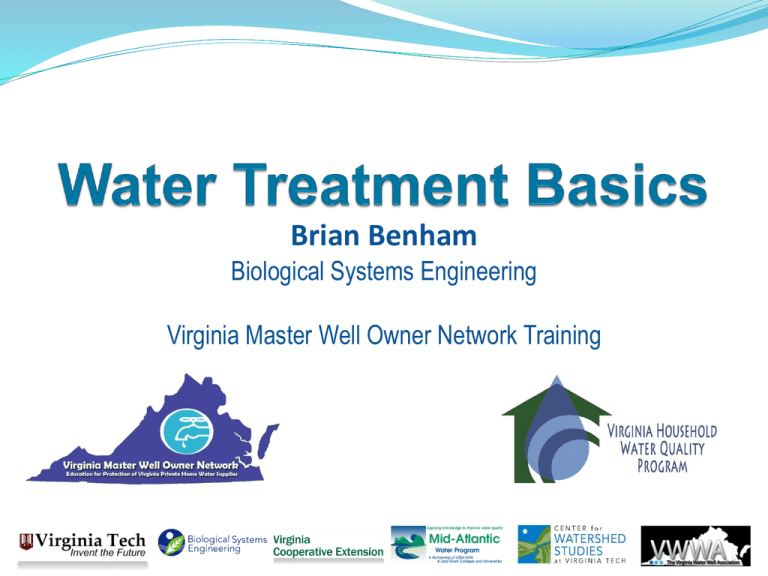
Brian Benham Biological Systems Engineering Virginia Master Well Owner Network Training Water treatment Overview Physical treatment Filtration Reverse Osmosis Adsorption Heating Ultraviolet light Chemical treatment Involves adding a solid liquid or gas to alter water chemistry Chlorination, ozonation, water softeners, acid neutralizing filters, Point of use (POU) – single faucet Point of entry (POE) – whole house Filtration Several types of filters Used for a variety of constituents Suspended solids (sediment) most common Can remove particulate iron and manganese (can see particles or imparts color to water) MUST match filter to target constituent(s) and Media filter integrate with other treatment components Pleated Cartridge Filter Filters: Media Removes suspended solids Often used as prefilter when constituents in raw water will harm or reduce effectiveness of other treatment devices “Media” can be variety of materials Sizing based on pore size and flow rate Maintenance involves periodic backwashing POE http://www.aquaflo.co.nz/images/filters/multimedia/Multimediatankcutout.jpg Filters: Cartridge Primarily for suspended solids Sized by pore opening and flow rate Maintenance involves periodically replacing cartridges POU or POE Pleated http://www.filtersfast.com/ProdImages/rs6-lg.jpg http://www.viledon-filter.co.uk/p/liquid/Cartridge_Filter_s40.jpg “Spun or Wound” Cartridge Filter Housing, Filter, Wrench http://thewaterexchange.net/wh34.jpg http://www.bestfilters.com/images/ProductImages/bfsf5020425.jpg Filters: Cartridge Filter Schematic Home Water treatment, NRAES-48 Reverse Osmosis – RO Effective for a variety of contaminants Analogous to a filter Relies on pressure to force water thru a membrane POU http://www.reverseosmosiscanada.com/ http://www.water-right.com/residential/reverse_osmosis/eclipse/eclipse.html Filtration Size Spectrum Human Hair Home Water treatment, NRAES-48 Filters: Activated Carbon Adsorption – contaminant binds to carbon Honeycomb-like structure provides enormous area for contaminants to bind to Effectiveness declines over time http://upload.wikimedia.org/wikipedia/commons/2/2d/Activated_Carbon.jpg Granular carbon most common in home treatment uses POU http://innofresh.files.wordpress.com/2009/04/photo-activated-carbon-2.jpg www.cee.vt.edu/ewr/environmental/teach/wtprimer/carbon/ccoal1.jpg Heating – Distillation Gas Vent Boiling and condensing Removes most dissolved constituents and can be effective for bacteria Low boiling point VOCs Condensing Coil Contaminated Water Coil water in coil used to condense steam (volitale organic compounds) may NOT be removed Limited capacity Steam Vapor POU Heating Element Distilled water to tank May need to have carbon filter Cleaning Drain http://www.everythingyoualwayswantedtoknow.com/watertreatment/DistillationProcess.gif Bacteria Treatment Options Remove source of contamination. May not be possible with springs and cisterns, some wells. If treatment required… Both physical and chemical options available Sanitary Well Cap UV radiation, chlorination, ozonation Typically POE Chlorine Injection Bacteria – Shock Chlorination Involves adding chlorine to the well/spring box/cistern Not a long-term solution – does not address source Should be done anytime well is “opened” Must know volume of water to be treated THE SHOCK CHLORINATION PROCESS 1. CLEAN AND OPEN WELL CASING 2. CALCULATE, MIX AND POUR 3. CIRCULATE 4. CLOSE AND LET STAND 5. FLUSH 6. RETEST Bacteria – Ultraviolet systems (UV) Disrupts bacteria/pathogen “life cycle” Advantages Disadvantages • • • • • • • Not effective in turbid (cloudy, muddy water) • Bulb housing can become coated, lessening light penetration • Bulbs wear out • No way to test effectiveness (i.e., can’t test for residual chlorine levels) Automatic Low contact time Low cost to operate More effective than chlorine Compact and easy to maintain No taste or odor Graphics courtesy Mike Heatwole Bacteria – Chlorine Injection Continuous disinfection Requires “contact” time High maintenance POE v Chlorine Metering Pump Check Valve v Well Head Chlorine Solution Tank Injection Valve Contact Pressure Pressure Pressure Tank Tank Tank Tank http://www.cleanwaterstore.com/chlorinator.html To house Filter System Bacteria – Ozonation Inject 03 – powerful oxidant Treat bacteria and dissolved Fe, Mn POE 1. Ozone Unit 2. Off Gas Tank 3. Filtration Clean Water Ozone Injection Well Pressure Tank http://www.ozonepurewater.com/HowWorks.htm Calcium and Magnesium ions in untreated water Ion exchange water softener Calcium and magnesium ions exchanged with sodium ions Increases salt concentration of Sodium ions on resin beads treated water Recharge cycle should be based on usage NOT time Discharge and dispose of brine Calcium and Magnesium ions on resign resin beads properly – differing opinions on discharging to septic systems Components Resin tank Brine tank (recharge resin) POE – can by pass cold water Brine Tank Water Softener (resin) http://www.watervalue.com/img/5600softenerillustration.jpg Sodium ions in treated water http://www.nesc.wvu.edu/smart/pdf/sourcewater/SFQ_FW07_backwash.pdf Removing Hardness Raising pH: Acid Neutralizing ‘Filter’ Uses calcite or calcite/magnesium oxide mixture depending on pH POE Increases hardness To drain Outlet Neutralizer Filter Pressure Tank http://crystalquest.com/Acid%20Neutralizing%20water%20filter.htm Wellhead www.cleanwaterstore.com/acid-neutralizer.html Treatment systems can be complex Example – Removing dissolved iron: Household Water Treatment, VCE 356-481 Chlorination to oxidize iron, filtering to remove oxidized iron, softening for hardness, carbon filter to remove chlorine residual Resource Home Water Quality Problems – Causes and Treatments: 356-482 Water Treatment “talking points” Treatment devices should be certified National Sanitation Foundation (NSF International) – www.nsf.org. Water Quality Association – www.wqa.org Water treatment professional Training and Certification WQA offers Certified Water Specialist (CWS) program levels 1 – 6 WQA “Find a Member” database http://wqa.org/members.cfm?section=3 Are others that have used service/made a purchase satisfied? What would they do differently? Beware of scams and pressure sales pitches. Have water tested at a certified lab. Test regularly. Be an INFORMED consumer!! Resource to help inform consumers Additional Resources Virginia Household Water Quality Program 540-231-9058 www.wellwater.bse.vt.edu Virginia Water Well Association 540-740-3329 www.vawaterwellassociation.org Water Quality Association 630-505-0160 www.wqa.org American Ground Water Trust 603-228-5444 www.agwt.org National Sanitation Foundation 734-769-8010 www.nsf.org USEPA Safe Drinking Water Hotline 800-426-4791 www.epa.gov/safewater/hotline Water Systems Council 202-625-4387 www.wellcarehotline.org National Groundwater Association 800 551.7379 www.ngwa.org Virginia Department of Health Office of Drinking Water 804-786-6278 www.vdh.state.va.us/DrinkingWater Local Health Departments -in the phone book under Government
